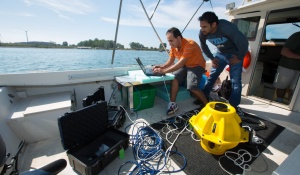EE Technical Innovations at UB: Here is How
Networking the oceans. Creating faster reliable wireless networks for the booming industry of wireless communication services and the Internet of Things. Reducing electronic devices to the nanoscale. Improving our ability to detect cancer. Making the electrical grid more efficient. Designing low cost medical imaging and health monitoring devices. Bringing accurate, portable, and affordable disease diagnostic tools at the point of care. Enabling machine learning that extracts reliable information from unreliable data.
That’s just a glimpse of what faculty and students in UB’s Department of Electrical Engineering are working on.
In recent years, it has been developing four areas of basic research that overlap each other like a Venn diagram. These areas are (i)electronics, (ii)optics and photonics, (iii)signals, communications and networking, and (iv)energy systems. EE faculty and student research activity in these interwoven areas lead to innovations in technology domains that lie in the core strategic directions of UB, including health, informatics, smart technologies, advanced manufacturing and nanotechnology, energy and the environment.
Health

In the health-related research domain, EE faculty at UB who specialize in optics and photonics train undergraduate seniors to build portable, smart-phone-attached photonic sensor systems for real-time monitoring of bio/chemical species and detection of diseases at the point of care. At the same time, faculty research in signal processing aims to improve the speed of magnetic resonance imaging (MRI) to allow scanning of organs that are always in motion. Other collaborative work with faculty in UB’s School of Medicine and Biological Sciences focuses on revolutionary brain-machine nano-interfaces for the development of transformative treatments for a number of brain/neuronal diseases.
Smart Technologies

Research efforts on smart technologies in EE at UB include pioneering work in the broad areas of signal processing and wireless communications with breakthrough applications on software-defined networking and cognitive communication architectures for over the air, underground and underwater information processing systems. Novel signal designs and prototype developments such as reflect array walls and dynamically reconfigurable transceivers aim to resolve wireless traffic jams and increase wireless data speeds and quality of service in next-generation Wi-Fi and cellular networks. In an effort to conquer the last wireless communication frontiers, EE faculty research and developments on underground and underwater networking has been on the forefront of international innovation, while software and hardware developments for rapid deployment of programmable aerial networks focus on disrupting traditional search-and-rescue operations.
Advanced Manufacturing and Nanotechnology

Sustained activities on nanomaterials and nanodevices in UB EE’s research portfolio offer important know-how to the advanced manufacturing community. Examples include revolutionary nanomanufacturing technologies to produce nanocomposite materials, as well as advanced devices for energy efficient computing. EE faculty's work on vortex lasers offers hope to continue building, beyond Moore’s law, more powerful computers and data centers while their developments on sensing technologies improve our ability to detect diseases, chemical weapons and more.
Energy and the Environment

EE faculty’s innovations for energy efficiency can be found all the way from the nano-scale (nanophotonic devices to harvest and convert solar energy) and the micro-scale (next generation power electronics capable of integrating renewable sources to the grid) to the macro scale (energy efficient communications, and smart grid). And when it comes to the environment, their research and development in cognitive underwater acoustics can be prime example of significant societal commercial technology impact in the form of environment-aware diver-to-diver-to-vessel-to-air communications, search and rescue operations, disaster prevention, pollution monitoring, and oceanographic data collection. Significant societal implications of revolutionary research in wireless underground communications include intelligent agriculture, pipeline fault diagnosis, mine disaster rescue, concealed border patrol, and crude oil exploration, among others.